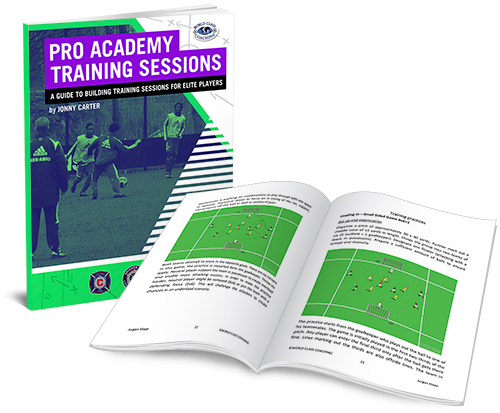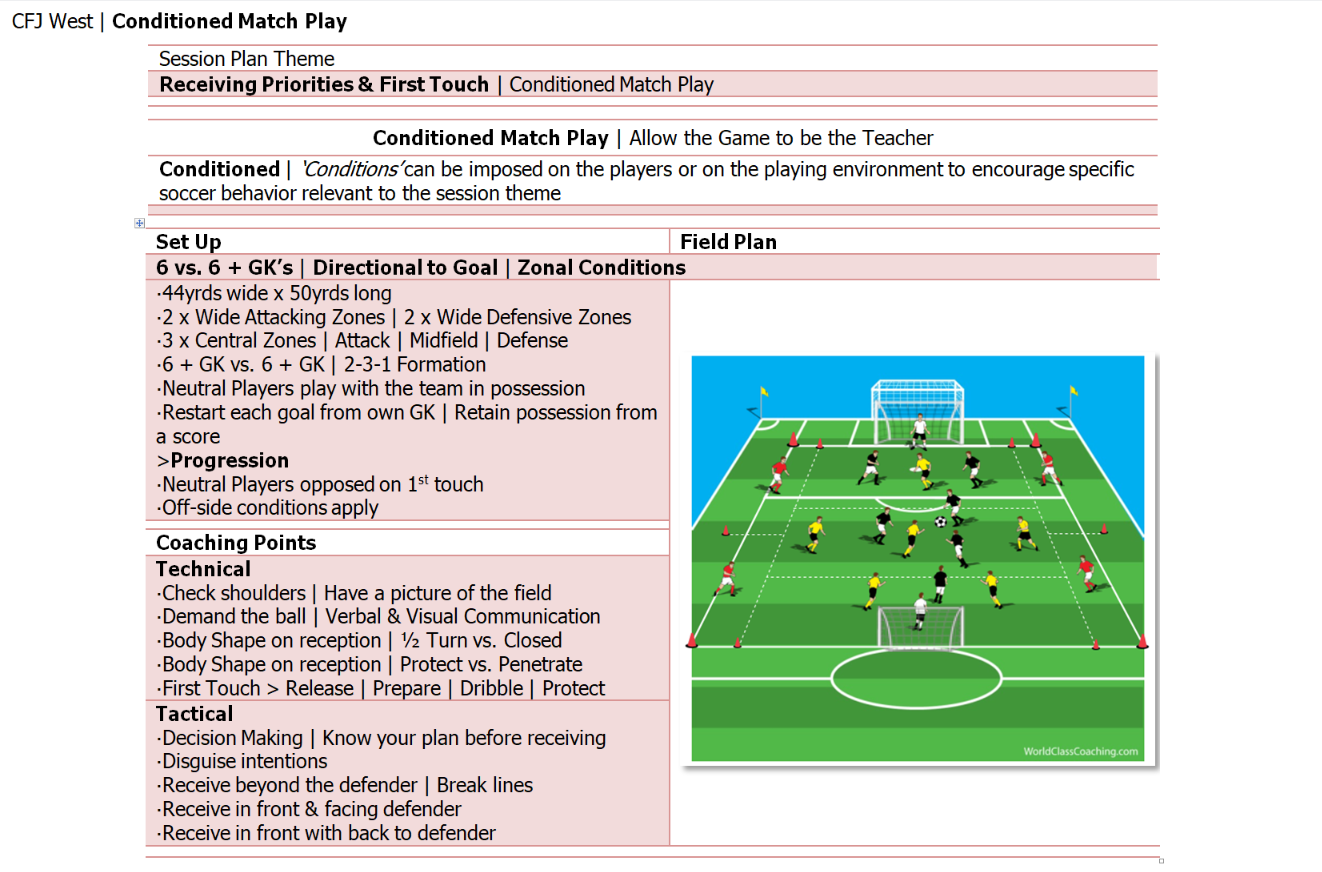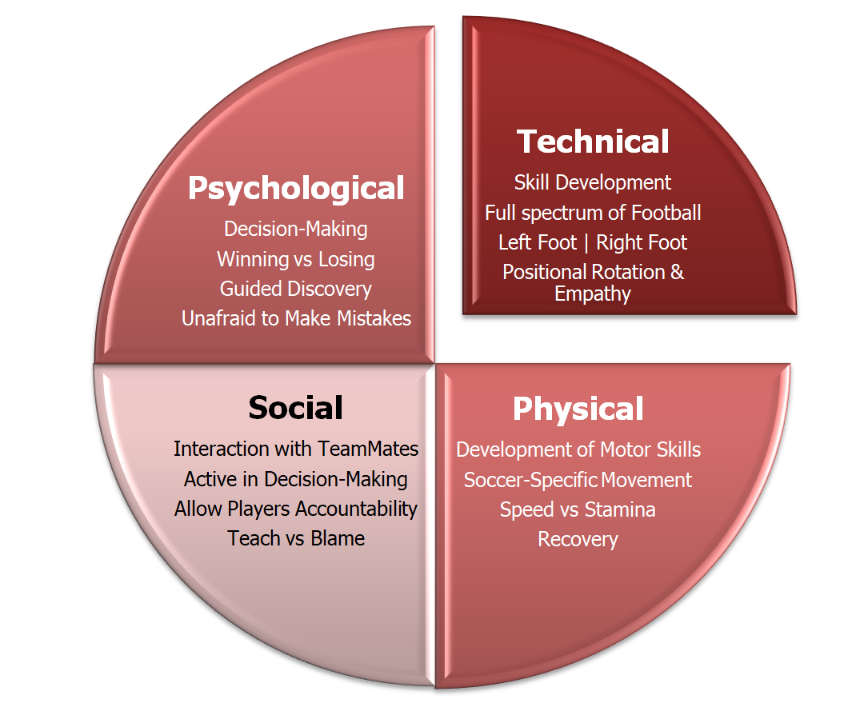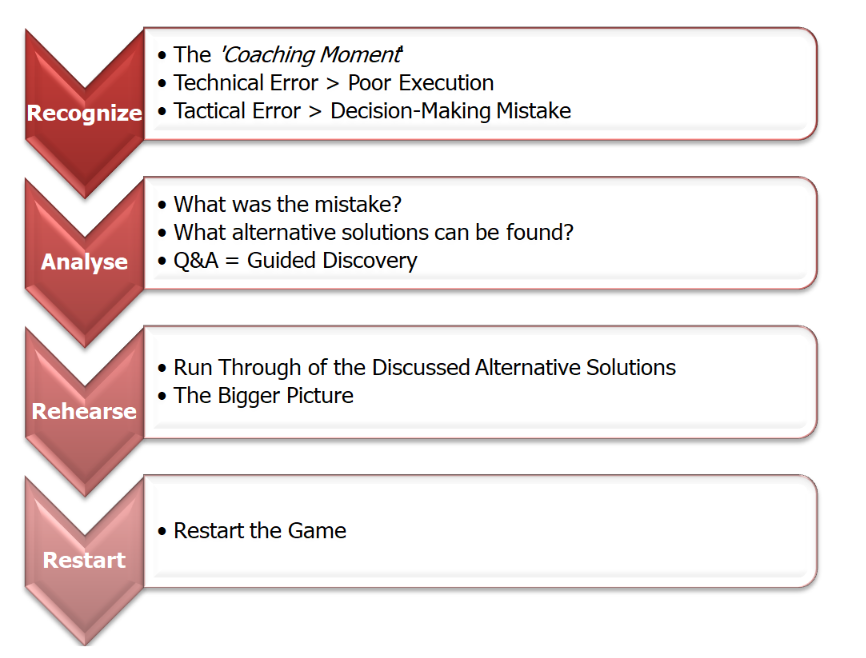WORLD CLASS COACHING
Pro Academy Training Sessions
By Jonny Carter

TABLE OF CONTENTS
Part Two
THE FOUR CORNERS MODEL
CLUB CORE VALUES
THE TEACHING METHODOLOGY
TOP 15 TIPS
Coaching Theory
Curriculum Building & Session Planning | Coaching Theory
Purpose of Season Planning |
Balanced range of themes across the season | Road map of where you are going in relation to the curriculum
Technical Training |
High Repetition Low Pressure | Unopposed • Simple • Realistic • Limited Decision-Making • Developmental • Challenging • Vehicle for CP’s
Game Related |
Opposed • Match-Like • Increased Decision-Making • Progressive • Stimulating • Tactical Information • Positive Reinforcement of CP’s
Game Specific |
Opposing Teams • Team-Mates • Match-Like Conditions • Tactical Decision-Making • Directional Play • Territorial Invasion • Goals | Targets • Transition of Possession • Testing of the CP’s
Conditioned Match Play |
Set-Up | Description of game & formation to be played
Rules | Specific game-play rules that are relevant
Principles | What ‘Attacking’, ‘Defensive’ & ‘Set-Piece’ subjects are we going to teach
Session Plan | The essential appendage
A documented session plan should be mandatory for all professional coaches. Certainly your Director of Coaching (DOC) will expect and demand that a documented session plan be presented.
Session plans don’t need to be large documents; rather bullet points and diagrams are more valuable than written text. Some wise suggestions are to plan more than you need, if something isn’t working for you then move on, you can always roll over any unused activity to the next training session. Concentrate on the few key coaching points, understand what you want to achieve with the exercises that you have picked, you need to teach the players not just ‘manage’ a safe activity. Try to consider where the player will go wrong, what mistakes can you predict they will make, and then when you spot the mistakes you are confident in the ‘coaching moment’ to make corrections.
Make the session plan neat and legible, especially if presenting it to a DOC, have your session plan represent you as a coach. It is good to retain your session plans for your own resource and also to share with others so make the plan worth keeping and worth presenting.
Sessions should be planned to be progressive.
Session Plan | What does ‘Progressive’ mean?
Training sessions should begin with the repetition of technical training in a low or no pressure environment. As the session moves on the degree of pressure the player is subjected to and the level of difficulty of the required task should increase – thus ‘progressive’.
Unopposed • Simple • Realistic • Limited Decision-Making • Developmental • Challenging • Vehicle for CP’s (Coaching Points)
By making the activity more difficult through the Game Related components players learn to develop their game play in line with their rate of success.
Session Plan | What does ‘Game Related’ mean?
Game Related means that exercises/drills need to have some relevance or connection to the game of soccer. There should be a progression into ‘Game Specific’ activities.
Opposed • Match-Like • Increased Decision-Making • Progressive • Stimulating • Tactical Information • Positive Reinforcement of CP’s
Session Plan | What does ‘Game Specific’ mean?
Game Specific means that exercises/drills have a recognizable connection to many of the rules and features of the full game. During the Game Specific components players have the opportunity to transfer their skills into the match environment
Opposing Teams • Team-Mates • Match-Like Conditions • Tactical Decision-Making • Directional Play • Territorial Invasion • Goals | Targets • Transition of Possession • Testing of the CP’s
Session Plan | What does ‘Conditioned Game’ mean?
Conditioned | ‘Conditions’ can be imposed on the players or on the playing environment to encourage specific soccer behavior relevant to the session theme.


Some soccer coaches may use different terminology to what is written here to define the stages of their session plan. Don’t get confused or obsessed with the name of the different components, yours, mine and theirs might all be different in name, but if you look at the definitions and work from those then the title becomes unimportant.

Four Corner Model | Coaching Theory
Pretty much all soccer organizations agree that some sort of ‘Four Corner Model’ should be considered when creating a session plan and when choosing content for the activities you are going to deliver. It is suggested that each corner of the model appear in some way and in some capacity within the session plan. Some components are easy to add to your session plan content and others require a little more deliberation.
But considering how and where you can enhance the social balance of your team or of your players is a valuable addition; Respect, Humility and Integrity are just as valuable components of your player’s profile as passing, dribbling and shooting.

Chicago Fire Juniors West | Club Core Values
Dedication - Devotion and perseverance of the pursuit of excellence
Respect - Courtesy and admiration for teammates, game officials, opposition-Respect for your own personal development
Humility - Display of modesty in victory and dignity in defeat
Desire - A passion to reach a distinction of effort
Accountability - Taking responsibility for your role, job or function within the group-Holding others answerable for their role, job or function within the group
Discipline - A representation of an attitude focused on education
Integrity - Representing yourself, your team and your club with honesty
Teamwork | Teammate
The Teaching Methodology | Coaching Theory
All soccer coaching organizations will have a version of a teaching methodology that they want their coaches to use when working with players and making technical and tactical corrections.

The Teaching Methodology | Coaching Theory
#1 | Recognize
Identify the mistake by the player. Was the error a ‘technical’ error of poor execution or was the error a ‘tactical’ error of poor decision making. It’s not possible to stop and correct every single mistake, so be selective of the correct ‘coaching moment’ and be sure to remain on topic, correct to the theme of your session plan.
#2 | Analyze
Find out what the mistake was. Why did the shot go over the crossbar, why was the pass misplaced, why did the 1 vs. 1 dribble fail? There is a reason, it’s never bad luck, evaluate what went wrong and how to correct it. Provide alternative solutions to any given soccer-specific problem; ideally with the help and understanding of the players concerned. Ensure that the players comprehend by validating their knowledge with questions, by guiding players to create their own solutions makes for more intellectual players rather than robots who merely follow the coach’s orders.
#3 | Rehearse
Provide the players concerned the opportunity to run through the discussed corrections and alternative solutions so a clear and accurate picture can be seen before returning back to the pressures of the training activity. Ensure that all players are engaged in the process. Try to coach the bigger picture and not just focus on the immediate player involved; suggest and recommend how each player connected to the play should respond to the revised passage of play.
#4 | Restart
Find a realistic method of restarting the game that recreates a similar scenario to the moment that you stopped the game. Evaluate whether the restart was successful enough to allow play to continue.
It is important to recognize that this whole process or some variation of this teaching methodology needs to be completed in a very short space of time. The players learn more through the repetition of the activity and less through verbal communication, also youth players can become disinterested by repeated or lengthy stoppages with too much talking. There is a balance between educating your players versus losing the atmosphere of your training session with boring lectures.
Top 15 Tips | Coaching Theory
#1 | What to Avoid
Avoid humiliation as a forfeit or punishment. Humiliation is not a preferred forfeit.
Avoid exercise as a forfeit or punishment. Running laps or doing press ups is not a preferred method of forfeit; coaches should be trying to encourage correct athletic behavior not taint it.
#2 | Coaching Position
Ensure that you can view all your players at all times. Patrol the perimeter of the playing area and enter the middle when you need to make a coaching point. Don’t address a group with players behind you, have everyone in your field of vision. And have everyone attentive to your coaching.
#3 | Goalkeepers are part of Soccer And part of training
The goalkeeper has specific individual training requirements, but GK’s should be involved in outfield training sessions as much as possible. Minor modifications can be made to plenty of training exercises to accommodate a goalkeeper, and they should be accommodated.
#4 | T on T Time on Task
All learners, when learning any discipline, learn by doing. If you want to learn the piano, learn Spanish or learn soccer, the very best method is to keep doing it again, and again, and again. Coach’s talking time is much less valuable than a player’s playing time, ensure that the contact time with players is maximized with playing and not over talking…or prolonged resting, or lengthy drinks breaks, or waiting in lines etc.
Coaching points must be concise, and consider if it is necessary to stop a full session to address individual players unless it is appropriate to do so; coach 1 to 1 or in small groups rather than halting an entire training exercise.
#5 | Elimination Games
Elimination games remove a player from participating in an activity usually because they have failed to perform that activity to the required standard. If a player is eliminated then they are robbed of the opportunity to practice and therefore get better; perhaps good enough to avoid elimination next time. Elimination has a reverse trend. Elimination from participation just accentuates the divide, so avoid elimination games at all costs.
If players do lose then allow a method of re-entry into the game that avoids humiliation or exercise as punishment e.g. five juggles and you re-cycle back in the game etc.
#6 | Positive Reinforcement
Be positive at all times and encourage good play rather than condemn poor play. Everybody responds better to support than to criticism; players are the same. If players are not performing how you want them to…then look at your session plan before you look to blame them.
#7 | Learn Players Name
This really does help with bonding between a coach and their players. Creating a strong connection and social bond within the group dynamic is important; learning names creates a more sincere environment. Take the courtesy to learn some relevant information about your players.
#8 | Consistency of Commands
It is helpful for players to have consistency of the commands and terminology used on the coaching field; this will aid with the explanation of rules and will define the coaching point with more clarity.
#9 | Be Concise with your Commands
It is valueless for the player when a coach shouts generic commands i.e., “send it”, “boot it”, “make a run”, “try and score”, “under control” or “…better quality”. Provide detail and information with your commands to add validity and solutions to your coaching.
#10 | Demonstrations Don’t talk; SHOW
Demonstrations are so much more effective than verbal explanations, where possible show what you want rather than saying what you want. Ensure that demonstrations are executed exactly how you want the players to repeat. If you cannot demonstrate yourself then assign a player who can show the element in the most correct manner.
Don’t show players what not to do.
#11 | Stay on Theme
Sessions should be planned via the Season Plan to encompass the full range and spectrum of soccer to ensure a well-rounded and complete player. However, each training session should centre around one theme or topic with limited, minimal or no deviation into adjacent themes. Trying to teach every aspect of soccer too quickly is confusing and exasperating for the players; stick with one theme at a time and master components of soccer in consumable segments.
#12 | Small-Sided Games (SSG’s) Why?
4 vs. 4 is an essential soccer environment for youth development. Small-Sided Games allow intensity, touches and maximized participation for all players involved, and for all players to be involved. Every vital component of the game is realized during small sided soccer and by limiting the number of players and by rationalizing the field conditions players receive maximum exposure to game-play understanding and genuine involvement. (3 vs. 3 is the staple of the very young players for the same reasons).
#13 | In-The-Game Coaching
While some training sessions can appear heavily technically orientated there is ample opportunity for game play understanding to be developed and those coaching moments should be maximized within the Game Specific and Conditioned Match Play environment. These components can be opportunities to introduce and reinforce more of the tactical aspects of the game.
Youth soccer players will make plenty of mistakes but it is advised to refrain from trying to shout advice to players while they are ‘in the moment’, it is better to allow the player to make a decision and then to coach the player after the moment about possible alternative decisions. There is enough pressure on players already that the youth player will not be able to hear, understand and then react to a coach’s advice ‘in the moment’. The game field is not a chessboard where the coach can influence every move, allow the players to be ‘guided’ to ‘discover’ good decisions, not just be told the best idea through the eyes of a coach.
#14 | Coaching Points Coaching or Managing | Coaching or Commentating?
It is not enough for a coach just to arrange marker discs, hand out colors and oversee the running of a safe activity. The coach’s responsibility is to teach the game and content knowledge cannot be skipped over. The knowing of coaching points separates a coach who can teach the game against a phony who just manages drills. Ensure that coaching points are known and referenced on the session plan to maximize the player’s education.
Merely commentating on events as the training activity unfolds is not the same as coaching. Players require knowledgeable advice, detailed correction and to be taught how to improve; just remarking on passages of play is not the same as analyzing a player’s development.
#15 | Professionalism
Being accurate and diligent with the minutiae and detail is the difference between being good enough to scrape through or truly providing a strong education for your players. Professionalism in regard to every facet of coaching is the priority concern; some examples of professional requirements are…
• Uniform – dress appropriately for this important environment, it does get noticed
• Punctuality – do not be late, this doesn’t go down well with anyone concerned
• Presentation of equipment – set out your lines and field markings with care and attention, straight lines and same colored markers are achievable
• Attitude – Be confident in your abilities and bring energy to your training environment


